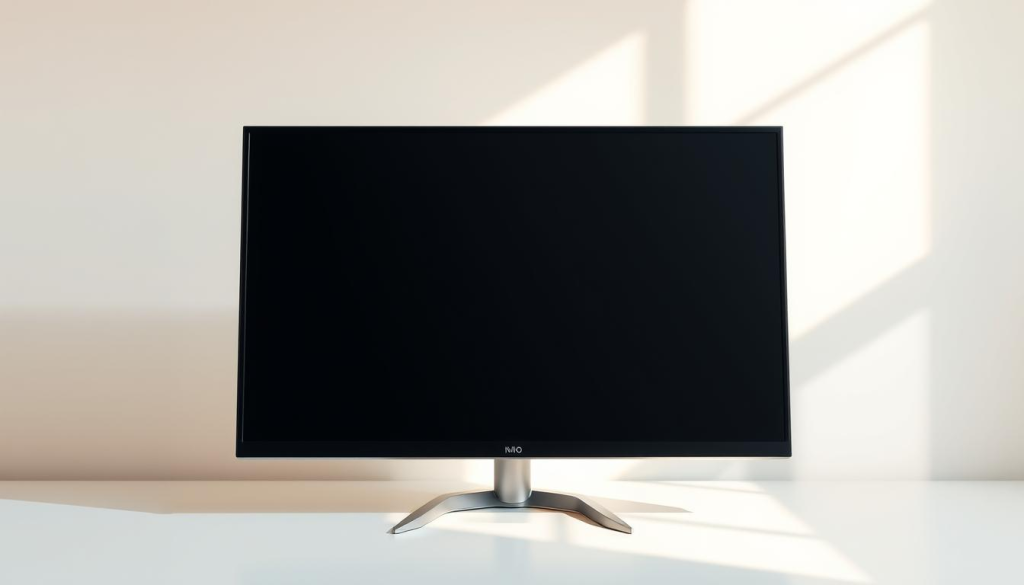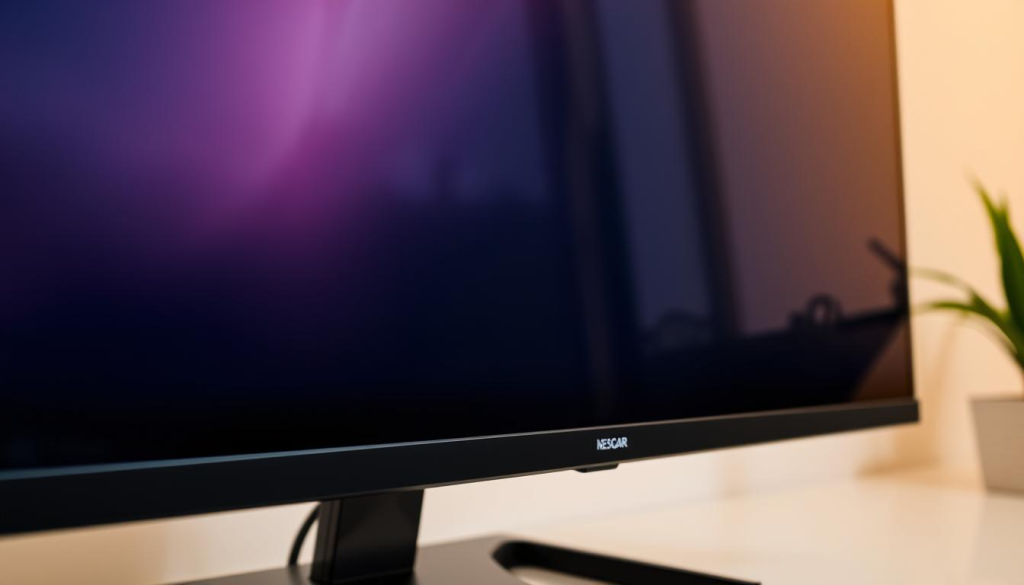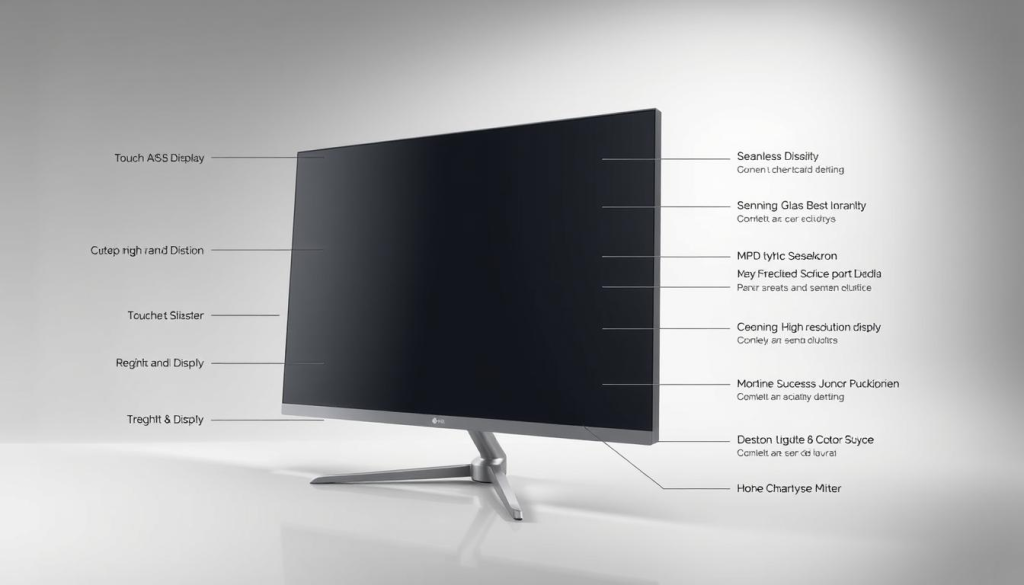In today’s world, interactive displays are key in many places. As more people work from home, they look for ways to work better and enjoy their time. Planar touch screen monitors offer great display quality and easy interaction for work and learning.
We’ll look at the best touch screen monitors for this year. We’ll check their features, what makes them special, and how they can be used. This will help you choose the right one for you.

Key Takeaways
- Planar touch screen monitors provide enhanced interactivity that supports various professional needs.
- High resolution options, such as Full HD and 4K, are key for tasks like graphic design and video production.
- Touchscreen accuracy and quick response are important for multitasking and staying productive.
- When picking a planar monitor, look at connectivity and how durable it is for daily use.
- Planar monitors are versatile, fitting into education, business, and creative fields.
Introduction to Planar Touch Screen Monitors
The planar touch screen monitor is leading the way in interactive display tech. It changes how we interact with visual content. These monitors use advanced touchscreen tech for easy interaction with info and apps just by touching the screen.
They are in high demand in education, business, and creative fields. Planar touch screen displays improve user experience with high-resolution displays and energy-saving features. They also support multiple touchpoints for better collaboration.
The 98-inch Planar UltraRes Touch LCD display is the world’s largest 4K touch display. It offers multitouch capabilities, supporting up to 32 touchpoints at once. This makes it great for group work and communication.
With the rise of remote work, these monitors have become even more important. They are flexible and adapt well to different work settings. They offer a sophisticated solution for boosting engagement and productivity in institutions and businesses.
Understanding Touch Screen Technology
Touch screen technology has changed how we use devices. It lets us control them by just touching the screen. This makes apps easier and more fun to use. Knowing how touch screens work is key for those looking for a good planar touch display.
What is Touch Screen Technology?
Touch screen technology lets us use devices by touching them. It can tell when you tap, slide, or make gestures with your finger or a stylus. Touch screens are now common in many areas, making them easy to use.
Types of Touch Screen Technologies
There are many types of touch screens, each with its own benefits. Knowing about these can help you pick the right one for you. Here are some common types:
- Resistive Touch Screens: These screens work with any device, like fingers or styluses, because they respond to pressure.
- Capacitive Touch Screens: These screens use your finger’s electrical charge to work. They allow for more than one touch at a time.
- Optical Touch Screens: These use infrared light to track touches. They’re tough and often found in kiosks.
- Infrared Touch Screens: These screens use infrared light beams to sense touches. They’re precise and don’t need you to touch the screen.
Benefits of Using Planar Touch Screen Monitors
Planar touch screen monitors bring many benefits. They improve both how things work and how we interact with them. These monitors are great in many places, like offices and schools. They make things more interactive, user-friendly, and save space.
Enhanced Interactivity
Planar touch screen monitors make things more interactive. They let users touch and move things on the screen easily. This makes presentations better and teamwork more effective.
Users can directly touch and change what’s on the screen. This makes working together and being creative easier. It’s very helpful in both work and school.
Improved User Experience
Using planar touch screen monitors makes things better for users. They have a quick response time and clear images. This makes using them fast and easy.
Users find it easier to navigate and work on these monitors. It makes them more productive and happy. The touch feature feels natural, making everything better.
Space-Saving Solutions
Planar monitors are also great because they save space. They are designed to be slim and fit in small areas. This is perfect for places where space is limited.
Even though they save space, they don’t lose any performance. They offer a great balance of function and convenience. This makes them perfect for any workspace.
Key Features to Look for in a Planar Touch Screen Monitor
When picking a planar touch screen monitor, knowing key features is important. Look at resolution, touch sensitivity, and connectivity. These aspects help decide if the monitor fits your needs.
Resolution and Display Quality
Display quality is key when choosing a planar touch screen monitor. A resolution of 1920 x 1080 pixels means clear images and bright colors. This makes watching content more enjoyable.
Monitors like the Planar PCT2265 have a brightness of 250 cd/m². This helps you see well in different lighting. Plus, with a contrast ratio of 1000:1, you get sharp images with clear light and dark areas.
Touch Sensitivity and Responsiveness
Touch sensitivity is important for using planar monitors. They support up to 10 touch points, great for multiple users at once. With a response time of 14 ms, interactions are smooth and fast.
Connectivity Options
Connectivity is vital for a monitor’s function. HDMI, DisplayPort, and USB ports make connecting devices easy. This ensures the monitor works well with many systems, from presentations to interactive displays.
Durability and Design
In busy places, durability is key. Planar monitors are built tough with features like Extended Ruggedness and Optics™ glass. They can handle daily wear and tear well.
They also have a removable base and VESA mounting for easy setup. Their design looks professional. This means they last a long time and perform well.

| Feature | Specification |
|---|---|
| Native Resolution | 1920 x 1080 |
| Screen Size | 21.5 inches |
| Viewing Angle | 178° Vertical, 178° Horizontal |
| Brightness | 250 cd/m² |
| Contrast Ratio | 1000:1 |
| Response Time | 14 ms |
| Touchscreen Type | Projected Capacitive (10 touch points) |
| Power Consumption | 27 W |
| Net Weight | 7.9 lbs |
| Warranty | 3-Year Limited Warranty |
| VESA Mounting | 100mm x 100mm |
Top Picks for Planar Touch Screen Monitors in 2025
In 2025, several top planar touch screen monitors have caught our eye. They stand out for their quality, user experience, and new features. Here are some of the best touchscreen monitors for different needs and preferences. Let’s take a closer look at our top picks for this year.
Planar UltraRes L Series
The Planar UltraRes L Series is known for its high HD and 4K resolution. It’s famous for its clear images and has won awards in education tech. It offers a top-notch viewing experience, perfect for work and school.
Users will love the monitor’s stunning visuals and interactive features. It’s a top choice among planar touch screen monitors.
Planar Helium PCT2435
The Planar Helium PCT2435 is made for creative professionals. It has a unique dual-hinge design for flexible use. The 24-inch screen and up to 75Hz refresh rate ensure smooth performance.
Its sleek design and advanced touch features make it a standout. It’s great for those who want both function and style.
ViewSonic TD2760
The ViewSonic TD2760 has a 27-inch screen and supports 10-point multitouch. It’s good for both work and personal use. With its 1080p resolution, users get smooth navigation and interaction.
This monitor is versatile and meets many user needs. It’s a solid choice for those looking for accessibility and advanced features.
Planar Touch Screen Monitor Specifications to Consider
Choosing the right planar touch screen monitor is key. You need to know about important specs that affect how well it works and how good it feels to use. Key specs include:
- Screen Size: The size should match the space it will be used in, from small classrooms to big conference rooms.
- Resolution: High resolution means clearer images, which is great for detailed work and presentations.
- Refresh Rates: A higher refresh rate makes things look smoother, which is good for fast-paced activities.
- Touch Technology: Different touch technologies, like capacitive or resistive, offer different levels of touch sensitivity and durability.
- Aspect Ratio: The right aspect ratio makes sure the monitor works well with common content formats.
- On-board Processing: Better processing power means the monitor can handle more tasks smoothly, making multitasking easier.
Matching these specs to your needs—whether for education, corporate use, or the creative fields—helps you make a better choice. Knowing these details helps you buy a monitor that meets your needs and improves your work or study experience.

Best Applications for Planar Touch Screen Monitors
Planar touch screen monitors are great for many areas, making things better. They help with interactions and presentations. They are perfect for many industries.
Education and Training
In education, these monitors are a game-changer. They make learning fun and interactive. Teachers can show things in a new way.
Students get to do things by hand, which helps them learn better. They can work together on projects. This helps them remember what they learn.
These screens create a world where everyone learns in their own way. It’s good for all kinds of learners.
Corporate Use and Presentations
At work, these monitors help with presentations and team work. They show things clearly, making meetings better. Companies use them to make presentations more interesting.
They make it easy for teams to share and work together, even if they’re far apart.
Creative Industries
For creatives, like designers and multimedia artists, these monitors are essential. They show high-quality images and work with touch. This lets artists play with their work in a new way.
They help creatives work better together. This makes bringing new ideas to life easier.
Comparing Leading Brands of Touch Screen Monitors
In the world of touch screen monitors, comparing brands is key to making the right choice. Each brand has its own strengths, meeting different needs. We’ll dive into Planar, Dell, and ViewSonic, looking at what they offer, their prices, and how users feel about them.
Planar vs Dell vs ViewSonic
Planar is known for top-notch displays and tech like ERO-LCD™. This tech makes screens last longer in tough places. Dell is great for those who want good value without giving up quality. ViewSonic is a favorite for schools and businesses because it’s affordable and works well.
| Feature | Planar | Dell | ViewSonic |
|---|---|---|---|
| Max Resolution | 3840×2160 pixels | 1920×1080 pixels | 2560×1440 pixels |
| Refresh Rate | 60Hz (DisplayPort) | 60Hz | 30Hz (HDMI) |
| Warranty | 3 years | 2 years | 3 years |
| User Support | Top-rated customer service | Good with some regional limitations | Responsive support |
These points are important for anyone looking at touch screen monitors. By comparing Planar, Dell, and ViewSonic, we see what each brand does best. This helps users choose the right one for their needs.
How to Optimize Your Planar Touch Screen Monitor Experience
To get the most out of your Planar touch screen monitor, focus on a few key areas. First, calibrate your monitor properly. This step improves accuracy and extends the device’s life.
Calibration and Maintenance Tips
Calibration is vital for keeping your monitor touch-sensitive and clear. Start with the built-in calibration tools in your operating system. Adjustments can usually be made through on-screen instructions.
Also, clean your screen often with a microfiber cloth. This keeps it clear and responsive to touch. Following these tips will help your monitor’s 1920 x 1080 resolution and 10-point multi-touch work at their peak.
Best Software Applications for Touch Control
Choosing the right software can greatly enhance your touch screen experience. Look for apps that recognize gestures well and let you customize the interface. This makes using the monitor smooth in places like retail, schools, or creative spaces.
Apps that support multi-touch gestures are best. They make the most of your device, improving work and teamwork. Good software can make your Planar touch display more efficient and enjoyable to use.
FAQ
What are planar touch screen monitors?
Planar touch screen monitors are advanced displays that let users interact with the screen. They are great for education and corporate settings, making things more engaging.
How does touch screen technology work?
Touch screen technology lets users interact with devices by touching them. It uses different types like resistive, capacitive, optical, or infrared. Each type has its own benefits for user interaction.
What are the benefits of using planar touch screen monitors?
These monitors offer better interaction and a smoother user experience. They save space and are perfect for presentations. They also work well in small areas or kiosks.
What features should I look for in a planar touch screen monitor?
Look for high resolution and display quality. Touch sensitivity and quick responses are key. Also, consider connectivity options and durability for busy areas.
Which planar touch screen monitors are highly recommended for 2025?
Top picks include the Planar UltraRes L Series for its high resolution. The Planar Helium PCT2435 has a great design. The ViewSonic TD2760 is great for multitouch needs.
What specifications are important when choosing a planar touch screen monitor?
Screen size, resolution, and refresh rates matter. So do touch technology types and aspect ratios. On-board processing is also important for performance.
In what environments are planar touch screen monitors most useful?
They’re great in education for interactive learning. They’re also useful in corporate settings for presentations. Creative industries benefit from their dynamic nature.
How do Planar monitors compare with other brands like Dell and ViewSonic?
Planar is known for durability with ERO-LCD™. Dell and ViewSonic focus on affordability and portability. They cater to different needs in the market.
What tips can help enhance my experience with planar touch screen monitors?
Calibrate your monitor regularly for best touch response. Use software that supports touch control. This will improve your overall experience with interactive displays.